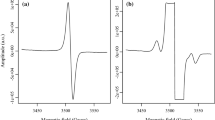Abstract
We herein report on the calculation of the activation energy (E a) from the thermoluminescence (TL) glow curves performed by the initial rise method that allows us to discriminate between irradiated and non-irradiated sesame seeds. E a values of natural TL (0.68 ± 0.03 eV) and gamma-induced TL (never lower than 0.82 ± 0.02 eV) appear as a complementary criterion to be used differentiating between irradiated and non-irradiated foodstuffs with the position and the intensity of the main peak of the TL emission. In addition, E a values taken from irradiated sesame samples at different doses (1, 5 and 10 kGy) and stored up to 15 months after being processed were compared to a ‘positive’ Spanish blend (i.e. at least one component was commercially irradiated).



Similar content being viewed by others
References
EN 1788 (2001) Thermoluminescence detection of irradiated food from which silicate minerals can be isolated. European Committee for Standardization, Brussels
McKeever SWS (1985) Thermoluminescence of solids. Cambridge Univ. Press, New York
Correcher V, Gomez-Ros JM, Garcia-Guinea J (2004) Radiation effect on the 400 nm-thermoluminescence emission of a potassium rich feldspar. Radiat Meas 38(4–6):689–693
Correcher V, Gomez-Ros JM, Garcia-Guinea J, Lis M, Sanchez-Munoz L (2008) Calculation of the activation energy in a continuous trap distribution system of a charoite silicate using initial rise and TL glow curve fitting methods. Radiat Meas 43:269–272
Favalli A, Furetta C, Cruz-Zaragoza E, Reyes A (2006) Computerized glow curve deconvolution of thermoluminescent emission from polyminerals of Jamaica Mexican flower. Radiat Eff Defects Sol 161:591–602
Rawat NS, Kulkarni MS, Mishra DR, Bhatt BC, Sunta CM, Gupta SK, Sharma DN (2009) Use of initial rise method to analyze a general-order kinetic thermoluminescence glow curve. Nucl Instrum Methods B 267:3475–3479
Chen R, McKeever SWS (1997) Theory of thermoluminescence and related phenomena. World Scientific Publishing, Singapore
Correcher V, Muniz JL, Gomez-Ros JM (1998) Dose dependence and fading effect of the thermoluminescence intensities in gamma-irradiated paprika. J Sci Food Agric 76:149–155
Garcia-Guinea J, Correcher V (2000) Luminescence spectra of alkali feldspars: influence of crushing on the ultraviolet emission band. Spectrosc Lett 33(1):103–113
Beneitez P, Correcher V, Millan A, Calderon T (1994) Thermoluminescence analysis for testing the irradiation spices. J Radioanal Nucl Chem 185:401–410
Bøtter-Jensen L, Duller GAT (1992) A new system for measuring optically stimulated luminescence from quartz samples. Nucl Tracks Radiat Meas D 20:549–553
Calderon T, Correcher V, Millan A, Beneitez P, Rendell HM, Larsson M, Townsend P, Wood RA (1995) New data on thermoluminescence of inorganic dust from herbs and spices. J Phys D Appl Phys 28:415–423
Correcher V, García-Guinea J (2011) Application of the EN1788 European standard for the control of saffron, pepper and blends. Food Control 22:173–179
Garcia-Guinea J, Correcher V, Sanchez-Munoz L, Finch AA, Hole DE, Townsend PD (2007) On the luminescence emission band at 340 nm of stressed tectosilicate lattices. Nucl Instrum Methods A 580:648–651
World Health Organization (1980) Wholesomeness of irradiated food, report of a joint FAO/lAEA (OIEA)/WHO (OMS) expert committee, technical report series 659. WHO, Geneva
Acknowledgments
This work has been partially supported by the Ministerio de Sanidad, Política Social e Igualdad-CIEMAT (2010/2931) contract.
Author information
Authors and Affiliations
Corresponding author
Rights and permissions
About this article
Cite this article
Correcher, V., Garcia-Guinea, J. Potential use of the activation energy value calculated from the thermoluminescence glow curves to detect irradiated food. J Radioanal Nucl Chem 298, 821–825 (2013). https://doi.org/10.1007/s10967-013-2473-3
Received:
Published:
Issue Date:
DOI: https://doi.org/10.1007/s10967-013-2473-3




